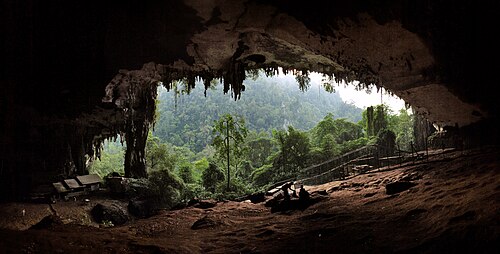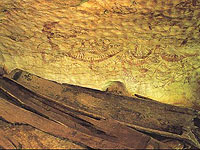1. Gunung Mulu National Park
2. Niah National Park
1. Gunung Mulu National Park
The national park is named after Mount Mulu, the second highest mountain in Sarawak.
Geology
Gunung Mulu National Park is famous for its limestone karst formations. Features include enormous caves, vast cave networks, rock pinnacles, cliffs and gorges. Gunung Mulu is a sandstone mountain rising to 2377m.
Gunung Mulu National Park has the largest known natural chamber or room - Sarawak Chamber, found in Gua Nasib Bagus. It is 2,300 feet (700 m) long, 1,300 feet (396 m) wide and at least 230 feet (70 m) high. It has been said that the chamber is so big that it could accommodate about 40 Boeing 747s, without overlapping their wings. The nearby Deer Cave was, for many years, considered the largest single cave passage in the world.
Other notable caves in this area are Benarat Cavern, Wind Cave, and Clearwater Cave; which contains parts one of the world's largest underground river systems and is believed to be the largest cave in the world by volume at 30,347,540 m³.
Mulu's limestones belong to the Melinau Formation and their age is between 17 and 40 million years (Late Eocene to Early Miocene).
Stratigraphically below the limestones, and forming the highest peaks in the south east sector of the Park including Gunung Mulu, lies the Mulu Formation (shales and sandstones). The age of these rocks is between 40 and 90 million years (Late Cretaceous to Late Eocene).
Fauna
Eight species of hornbill have been spotted in Mulu including the Rhinoceros Hornbill Buceros rhinoceros which features on Sarawak state emblem, the White-crowned Hornbill Berenicornis/Aceros comatus and the Helmeted Hornbill Buceros vigil with its large solid casque (bill).
Twenty seven species of bat have been recorded in Mulu. Deer Cave in the southern limestone hills of the park is home to an enormous colony of Wrinkle-lipped bats (Tadarida plicata). The bats exit the cave almost every evening in search of food in a spectacular exodus. A huge mound of guano in the cave is evidence of the size of the bat colony that roosts in the cave's high ceilings.
Mulu's mammals also include the Bearded pig Sus barbatus, the moonrat Echinosorex gymnurus, shrews, the Bornean Tarsier Tarsius bancanus, the long-tailed Macaque Macaca fascicularis, gibbons, squirrels, and three types of deer including the small barking deer and mouse deer. The small Malaysian sun bear Helarctos malayanus, which is the only bear known in South-East Asia, has also been identified in Gunung Mulu National Park.
Flora
Gunung Mulu National Park contains a large number of plant species, including flowering plants, trees, and fungi. Geology, soil types and topography have given rise to a rich tapestry of plant zones and types. On Gunung Mulu itself these include lowland mixed dipterocarp forest, lower montane forest, mossy or upper montane forest and summit zone vegetation on the highest peaks. On thelimestones there is lowland limestone forest as well as lower and upper montane limestone forest. Other plant communities dominate the alluvial plains, including kerangas (tropical heath forest) and peatswamp forest.
The Bat Exodus
Twelve species of bats have been recorded within Deer Cave, including the colony of Wrinkled-Lipped Bats estimated to number between 2.5 and 3.5 million individuals.
 While you wait in the Bat Observatory for the nightly flight of bats to begin you can watch the secret life of millions of bats on MULU BAT CAM a remote controlled, closed circuit TV system which takes you into the dark recesses of the cave to observe the bats ‘live,’ up close and sometimes a bit personal!.
While you wait in the Bat Observatory for the nightly flight of bats to begin you can watch the secret life of millions of bats on MULU BAT CAM a remote controlled, closed circuit TV system which takes you into the dark recesses of the cave to observe the bats ‘live,’ up close and sometimes a bit personal!. Expectation builds as the sun moves towards the horizon and the Bat Hawks take up their roost on the cliff face, waiting for the first of the millions of bats appear. Each evening the bats gather at the cave entrance in large ring-shaped formations, circling higher and higher up the cliff face before moving out across the rainforest in spiraling ribbons.
 It has been estimated that nightly each bat consumes between five and ten grams of flying insects. This means that 3 million bats will return in the morning to deposit a huge amount of guano in the cave and provide a unique ecosystem, home to millions of insects and their predators.
It has been estimated that nightly each bat consumes between five and ten grams of flying insects. This means that 3 million bats will return in the morning to deposit a huge amount of guano in the cave and provide a unique ecosystem, home to millions of insects and their predators.The bats leave the cave on most evenings between 5.30 pm and 6.30 pm but on rare occasions do not leave at all. Even more rarely they sometimes leave as early as 4.30pm!
The return trip to Park HQ is a wonderful time to move through the forest, listening to the calls of the frogs and insects, often seeing fireflies and stick insects.
Visit Clearwater Cave and Cave of the Winds in the mornings


After visiting the cave of the Winds - a really cool place - your Guide will take you on a short walk further along the river to the nearby Clearwater Cave where the river roaring beneath your feet has travelled its subterranean route for over 170km. Giant logs thrown high on the banks and wedged under boulders are evidence of the power of this mighty underground river. Swimming is not permitted in the cave however once you are back outside of the cave you can enjoy a swim in the crystal-clear waters where the river emerges from the cliff face. Float with the fish and enjoy the rainforest around you. Take a picnic lunch and relax at the Clearwater picnic site.
2. Niah National Park

History
 Niah’s importance was first realised in 1957. The curator of the Sarawak Museum, Tom Harrisson, led an archaeological dig at the West Mouth of the Great Cave. The excavations revealed plenty of evidence of human settlements in the area; tools, cooking utensils and ornaments, made of bone, stone or clay. The types of items found suggested a long period of settlement reaching back into the Palaeolithic era (the earliest part of the stone age).
Niah’s importance was first realised in 1957. The curator of the Sarawak Museum, Tom Harrisson, led an archaeological dig at the West Mouth of the Great Cave. The excavations revealed plenty of evidence of human settlements in the area; tools, cooking utensils and ornaments, made of bone, stone or clay. The types of items found suggested a long period of settlement reaching back into the Palaeolithic era (the earliest part of the stone age).In 1958, a discovery was made which confirmed Niah as a site of major archaeological significance. Harrisson and his team unearthed a skull which was estimated to be 40,000 years old. The find was at first ridiculed by the scientific community, for it was the skull of a modern human (homo sapiens sapiens), and it was widely believed that Borneo was settled much later. However, as dating techniques improved, and as more evidence of the settlement of Southeast Asia and Australasia came to light, Harrisson was proved right.
What is most interesting about Niah, however, is the continued human presence over tens of thousands of years, and the sophistication of the societies that gradually developed there. A large burial site further into the mouth of the cave had clearly been used from Palaeolithic times right up to the modern era, as late as 1400 AD. The earliest graves, found in the deepest levels, were simple shallow graves without adornment. Yet moving up through the layers, coffins and urns appeared, along with grave goods such as pottery, textiles and ornaments, and even glass and metal items, which came comparatively late to Borneo.

The Great Cave is not the only important archaeological site. The Painted Cave, as its name suggests, houses detailed wall-paintings depicting the boat journey of the dead into the afterlife. The meaning of the paintings was explained by the discovery of a number of “death-ships” on the cave floor - boat-shaped coffins containing the remains of the deceased and a selection of grave-goods considered useful in the afterlife, such as Chinese ceramics, ornaments and glass beads. The death-ships have been dated as ranging between 1 AD and 780 AD, although local Penan folklore tells of the use of death-ship burials as late as the 19th century.
Birds Nests
Collecting the nests from the cave ceiling is a dangerous job, and fatalities are not uncommon, but the price of raw bird’s nests is so high (over US$1,000 per kilo for the best quality) that the risks seem worthwhile. Obviously such a valuable commodity is a magnet for poachers, and over-harvesting is a constant worry. Therefore the caves are constantly monitored by park management to deter illegal collectors.
NOTE : Visitors cannot be sure of seeing birds nest collectors in action, as harvesting is a seasonal activity, and is subject to temporary bans by Sarawak Forestry to protect swiftlet populations.
Wildlife
Treks and Trails
The park has two well-marked walking trails, Bukit Kasut Trail and Madu Trail.
1. Bukit Kasut Trail
This trail (green and white markings) leads to the summit of Bukit Kasut. The 45 minute walk passes through beautiful primary rainforest before moving into Kerangas forest at the foot of the hill. You will also see some fascinating cliff vegetation clinging tenuously to life in the steep limestone slopes. The trail is a little steep but the view at the top is worth it, offering a sweeping panorama of the rainforest canopy.
2. Madu Trail
This trail (red and white markings) sticks quite close to the banks of the Sungai Subis, a tributary of the Sungai Niah. It takes roughly an hour and passes through both alluvial and peat swamp forest, leading to the foot of Bukit Kasut. There are plenty of wild orchids, bizarre mushrooms and giant pandanus plants along the side of the trail.

No comments:
Post a Comment